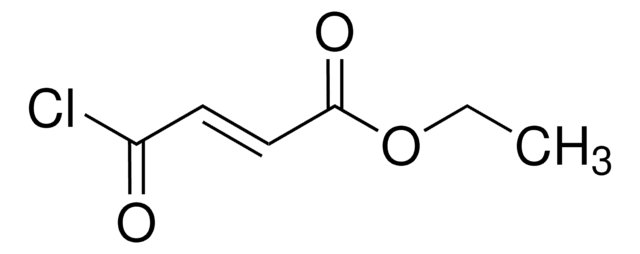338303
Chloroethane solution
2.0 M in tert-butyl methyl ether, anhydrous
Sinónimos:
Ethyl chloride
About This Item
Productos recomendados
grado
anhydrous
Nivel de calidad
densidad de vapor
2.22 (vs air)
presión de vapor
20.03 psi ( 55 °C)
5.98 psi ( 20 °C)
Formulario
liquid
temp. de autoignición
966 °F
concentración
2.0 M in tert-butyl methyl ether
impurezas
<0.005% water
densidad
0.775 g/mL at 25 °C
grupo funcional
alkyl halide
chloro
temp. de almacenamiento
2-8°C
cadena SMILES
CCCl
InChI
1S/C2H5Cl/c1-2-3/h2H2,1H3
Clave InChI
HRYZWHHZPQKTII-UHFFFAOYSA-N
¿Está buscando productos similares? Visita Guía de comparación de productos
Descripción general
Aplicación
- Green solvent in biomaterial extraction: Research highlights the use of Chloroethane as an effective solvent for extracting lignin-containing nanocellulose fibrils from date palm waste, emphasizing its potential in enhancing the sustainability of biomaterial processing (Raza et al., 2024).
Envase
Compatible with the following:
- Aldrich® Sure/Pac™ station for liquefied gases Z566446
- PTFE Sealing tape Z104388 or Z221880
- Straight septum-inlet adapter Z118141 with septa Z565687 or Z565695
Información legal
Opcional
adaptador de entrada de la membrana de goma
también adquirido normalmente con este producto
Palabra de señalización
Danger
Frases de peligro
Consejos de prudencia
Clasificaciones de peligro
Carc. 2 - Flam. Liq. 2 - Repr. 1B - Skin Irrit. 2
Código de clase de almacenamiento
3 - Flammable liquids
Clase de riesgo para el agua (WGK)
WGK 2
Punto de inflamabilidad (°F)
-29.2 °F - closed cup
Punto de inflamabilidad (°C)
-34 °C - closed cup
Elija entre una de las versiones más recientes:
¿Ya tiene este producto?
Encuentre la documentación para los productos que ha comprado recientemente en la Biblioteca de documentos.
Nuestro equipo de científicos tiene experiencia en todas las áreas de investigación: Ciencias de la vida, Ciencia de los materiales, Síntesis química, Cromatografía, Analítica y muchas otras.
Póngase en contacto con el Servicio técnico









